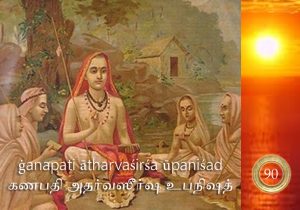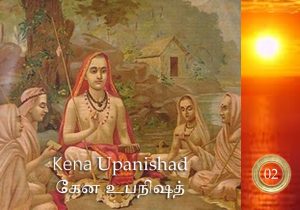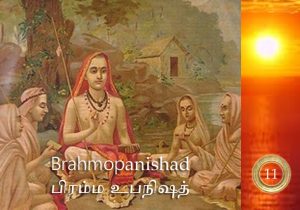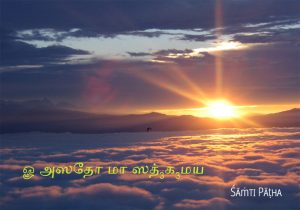Inspired Interpretation
ॐ असतो मा सद्गमय ।
तमसो मा ज्योतिर्गमय ।
मृत्योर्मा अमृतं गमय ।
ॐ शान्तिः शान्तिः शान्तिः ॥
ōṁ asatō mā sadgamaya |
tamasō mā jyōtirgamaya |
mr̥tyōrmā amr̥taṁ gamaya |
ōṁ śāntiḥ śāntiḥ śāntiḥ ||
The literal meaning of the mantrā is as follows:
OM!
From ‘non-reality’ (asatō ), make me move to (mā gamaya) ‘reality’ (sat); from ‘darkness’ (tamasō), make me move to (mā gamaya), ‘light’ (jyōtir); from ‘death’ (mr̥tyō), make me move to (mā sadgamaya) ‘immortality’ ( amr̥taṁ)!
Om! Peace, Peace, Peace!
Some translate the first-line for the move from ‘evil’ to ‘goodness’ and the second, for the move from ‘ignorance’ to ‘knowledge’. This fits well, as we all are forever wishing to perfect our actions and knowledge in worldly pursuits. But merely improving our actions and knowledge on the world of objects cannot culminate into the benefit of ‘immortality’, the goal sought in the third sentence of the mantrā. Therefore the true import of the mantrā requires a better and different understanding.
First, let us contemplate on the phrase ‘mā gamaya’.
The action indicated by the verb ‘gamaya means ‘make (one to) move’. The word ‘mā’ means ‘me’; so ‘mā gamaya’ translates to ‘make me move’. With the use of this phrase, it is clear that the Seeker is not praying for somehow the final goal to be magically granted, instead for the strength of necessary will, knowledge and action within her in order for the enriched endeavour towards the goal.
As Veda instructs, for one’s goal, one should always put right and righteous efforts (prayatanā), readily accept the outcome whatever those may be as the gift of God (Ishvarā-prashād) and all with the strength of good character (sadgunā) acquired through right conduct and knowledge. The use of the phrase, ‘mā gamaya’ implies that the Seeker is beseeching the grace of God for her to be empowered, and duly initiated, in her sojourn for perfection. One should earn the merits and strive for one’s goals. This is the first important insight of this mantrā.
The second important insight is that one should know one’s condition well. Only by knowing one’s state of affairs and the conditions, one can chart out a way forward. In this mantrā, the Seeker is aware of her conditions and the limitations, as she laments her state as one that is ‘bogus’, ‘dark’ and limited by the certainty of ‘death’.
The Seeker has recognized that her current state of affairs is somehow untenable; she does not feel any permanence in her being; fleeting changes make her lasting existence questionable; as death is proven to be a certainty, she does not feel any reality of her existence. Therefore, the Seeker sees her position as ‘asat’.
Understanding of the temporal nature of embodied life and its fleeting relationship with the world is a sign of spiritual maturity. But having such an understanding and doing nothing about it would only make one’s situation worse! After all, when one is ignorant of the pitiable nature of one’s own existence, at least there is no burden, as the veil of ignorance offers a sort of ‘bliss’; but when one understands one’s untenable condition, then there is only misery, with the burden of anxiety for a resolution. Therefore knowing that there is a way out of the misery is an important enabler for progress; it would mean there is ‘light at the end-of-tunnel’. This is the third important insight. In the mantrā , the Seeker is very clear about the solution to her miserable condition, for example, from ‘asat’, she aspires to move to ‘sat’.
Once the goal is known, the will to pursue should be duly acted upon and executed with the right intensity of purpose. But what if the will is there and the goal is also in sight, but there is no knowledge of the means to achieve? The only option is to seek guidance. Pray for the grace of GOD to steer to the divine feet of a Sadguru, who’s sword of instructions can cut asunder the veil of ignorance, revealing at once the goal, the supreme existence. Grace of God and the instructions of Sadguru are paramount. This is the fourth important insight.
For the contemplation of other words in the mantrā, we must also set the context. The supreme goal revealed in the mantrā is to realize the SELF with the BRAHMAM.
We all have ideas about ourselves and therefore definitions of the SELF according to our perspectives. But what BRAHMAM, the one and all powerful GOD, is that we do not know. So we need to take the aid of Vedāntā for the definition of BRAHMAM.
BRAHMAM is incomprehensible and indescribable. This is the assertion of Veda. Yet, BRAHMAM must somehow be realized and for this purpose the Taittiriya Upanishad offers a solution; with three words, it indicates the BRAHMAM as
सत्यं ज्ञानमन्तं ब्रह्म
satyaṃ jñānamantaṃ brahma
According to Bhagavān Sankarā, the terms satyam, jñānam and anantam cannot be considered as adjectives. After all, an adjective is a delimiter of an object from objects of the same class. But BRAHMAM is ‘ONE’ and not an object. Hence these terms should be taken not describing but defining BRAHMAM.
According to Vedāntā, SATYAM refers to immutable existence, that which exists at all times (trikālalbādhyam) and therefore beyond time, as eternal and changeless.
But when considered as the cause of all manifestations, BRAHMAM becomes mutable. This contradiction is addressed by the definition, Jñānam Brahma. i.e., knowledge or consciousness is BRAHMAM. If BRAHMAM is taken as the ‘Knower’, then by definition, becomes one of changing nature because the knowledge of objects keeps on changing as objects change. As this leads to a contradiction, BRAHMAM should be the very essence of knowing or the cognition. Thus with the use of the abstract noun Jñānam, BRAHMAM is indicated as pure knowledge or consciousness.
Finally, as BRAHMAM is SATYAM and therefore beyond time, then BRAHMAM must also be beyond the limitation of SPACE; in other words, BRAHMAM is unlimited, unbounded, anantam.
Thus given the definition of BRAHMAM, we need to consider the SELF. For this we follow the Seeker in this mantrā, and contemplate on the pairs of opposites in each sentence of the mantrā, namely, ‘sat’-‘asat’, ‘tamas’-‘jyoti’ and ‘mrityu’-‘amritam’ are to be contemplated.
ōṁ asatō mā sadgamaya |
The words, ‘sat’ and ‘asat’ offer for many interpretations.
For example, in Gita (Chapter 17, verse 23), the Lord quotes the Veda mantrā
oṁ tat sad iti nirdeśo brahmaṇas tri-vidhaḥ smṛtaḥ
brāhmaṇās tena vedāś ca yajñāś ca vihitāḥ purā
Here the word ‘sat’ refers to the BRAHMAM.
In other places, the word ‘sat’ is used to indicate: ‘being’, ‘existence’, ‘real’, ‘unchanging’, ‘eternal’ etc. For example, in Gita (9.19), Lord says
tapāmy aham ahaṁ varṣaṁnigṛhṇāmy utsṛjāmi ca
amṛtaṁ caiva mṛtyuś casad asac cāham arjuna
Also in Sri Lalithā Sahasranāmam, Sri Lalithā is adored as both ‘bhāva’ and ‘abhāva’ (bhāvabhāva vinōodini).
Here the term ‘sat’ refers to ‘being’ or ‘existence’ and ‘asat’ to ‘non-being’, ‘non-existence’, ‘non-real’, ‘changing’, ‘temporal’ etc.
With these definitions, the first sentence leads to the following plea by the Seeker as:
‘from the non-being, make me move to the being’; (or) ‘from the non-reality, make me move to the reality’;‘ (or) from the non-existence, make me move to the existence’.
Why does the Seeker declare that her status is ‘asat’?
This is because the Seeker has understood the fallacy of her self-identification with her embodiment. Knowing that the body, mind and intellectual faculties are only the instruments for bringing objective experiences, she could not anymore identify herself with the body. The tangible gross-body (sthula-sariram) is evidently inert and perishable. The subtle body (sukshma-sariram), made up-of ‘mind ’ and the organs of perceptions is also not proven to have its independent existence. It behaves as ‘manas’ for hosting recurring-thoughts; as ‘cittam’ for the depository of thoughts; as ‘buddhi’ for discriminating thoughts and as ‘ahamkāra’, for holding the false identify of the SELF. With all these roles, mind is forever vacillating and acting only on some borrowed power of ‘sentience’, for it is seen naturally inert during the deep-sleep. Therefore, the Seeker thinks:
I am not my body and mind and so where is my being? As I give up the identification with the embodiment, who then am I? In a state of non-being (abhāvā) from the perspectives of embodiment , where is my being (bhāvā)? Oh God, my efforts alone cannot reveal my true nature! May Your benign grace empower me to move from this state of non-being to the state of eternal being!
The goal of the first sentence is therefore to realize: ‘I am the sat’.
tamasō mā jyōtirgamaya |
Having realized the inertness of the gross and subtle-bodies, the Seeker considers those as ‘asat’ and drops the identification with the embodiments. Then what is ‘sat’ that gives the ‘sentience’ to the inert bodies, this she aspires to know.
Veda declares jñānam Brahma: the effulgence of BRAHMAM is the Supra-consciousness and it pervades as the indwelling awareness or consciousness in all beings: That Which gives sentience to mind yet beyond the comprehension of the mind. That is Ātma, and the ‘sat’ to which the Seeker seeks to identify the SELF with.
But merely hearing such words of wisdom is only of limited use as one needs specific qualifications to be able to absorb the Truth and attain Self-realization. What are the means for attaining the required qualifications and self-realization?
These the Seeker does not know and therefore she feels like dwelling in eternal darkness of ignorance and helplessness. She now understands the uselessness of all worldly knowledge and scholarships when the goal is Self-realization. She concedes to the assertions of Veda that education leading to Self-realization alone is vidyā. All material knowledge turns our focus away from the SELF and thus promotes ignorance about the SELF. As Bhagavān Sankarā declares avidyā is anything that hides or inhibits the knowledge of the SELF.
The Seeker realizes that her blinding darkness is avidyā and the escape is the light, Ātma-vidyā , the knowledge that leads to the true realization of the SELF can help. Owing to her spiritual maturity, the Seeker understands only Ātma-vidyā as the ‘glimpse of hope’ as she sees as he lustre at the end of the tunnel’.
Then she wonders: How could the SELF be ever known! As knowing oneself amounts to ‘knowing the knower’, seeing oneself to ‘seeing the seer’ etc., this seems an impossible task. If a ‘thing’ is to be known, or to be seen, then the ‘thing’ must be objectified. But anything objectified cannot be ‘sat’, as it becomes bounded and classified. So, the Seeker laments:
Alas, as I now know of my false identification with the embodiments, I took my identity away from them, and as a result, now being stranded in a state of darkness, not knowing the true identify of the SELF. As the mind being the only instrument for knowing, when I discard the mind as inert, then I don’t know of any option to comprehend the SELF. Perhaps, the SELF is not an object for comprehension! SELF is Who comprehends. As the knower is never known, I concur with Veda that the ‘knower’ and ‘to be known’ must be the same! In other words, SELF is the KNOWLEDGE itself that is beyond the mind. But what can be beyond the mind that knows the mind? It must be the inherent awareness known as ‘cit’ in Vedāntā. Awareness is the pure witness as I am aware of my ignorance, I am aware of knowledge. So this indwelling awareness should be the light of sentience and That must be the SELF. So instead of trying to know the unknown in the darkness of avidyā, I must stop the effort of knowing through the faculty of mind, and simply find the way to rid of avidyā, the darkness, the veil of ignorance, once for all! O God, You are the omniscient light, May your lustre lit my heart, and at the very moment May the darkness go, revealing the ever shining light of the SELF!
This is the import of the second sentence and its goal is to realize that ‘I am the cit’.
mr̥tyōrmā amr̥taṁ gamaya |
The culmination of benefits from the first two sentences gives the result of the third sentence, namely, ‘immortality’.
Here the Seeker is asking for moving from the state of ‘mortality’ to ‘immortality’.
Mortality refers to death; as death leads to birth thereinafter, the vicious cycle of birth and death continues, which is the cause of all grief. This is termed as ‘samsāra’. So mortality is samsāra and immortality is the release from the shackles of samsāra.
According to Vedāntā, not knowing the SELF as the BRAHMAM causes separation and this separation is samsāra.
First, the separation creates duality; false identification of the SELF creates the ‘I-egoity’ (ahamkāra) and a sense of ownership like ‘my’, ‘mine’ etc. (mamakāra) which in turn leads to the afflictions by attachments-aversions (rāga-dveshā) and fear (bhayā).
The attachment-aversion generates actions that are driven by selfish-desires only; such actions (kāmya karmā) lead to an accumulation of outcomes (karma-phala) only to be expended through one’s embodied experiences in the world; Thus is the trap into samsāra.
Secondly, fears arises from separation. The greatest of all fears is the fear of death. As death is certain, one should not be surprised of its arrival and therefore harbor any fear. But owing to the false identification of the SELF and attachments, the dread of death continues to exist and grow, as desires leading to kāmya karmā grow.
Here the Seeker is not an ordinary person. While she concedes to the inevitability of death, she is sure of the possible immortality. Since embodiments fall prey to death at some stage, the state of immortality cannot be associated with the embodiments. By moving away from ‘asat’ to ‘sat’, the Seeker has already disowned the embodiments as non-self, so the SELF must be untouched by death. Somehow this is not realized due to ignorance.
Therefore by moving from ‘tamas’, the darkness of ignorance to ‘jyoti’, the light of knowledge, the Seeker is asking for the true course for enlightenment, ātma-vidyā, in which the oneness with the universal consciousness is imparted. The prayer now is for the move from ‘death’ to ‘immortality’.
When the fear of death is not there, then for a virtuous Seeker, the bondage of attachments is also no more. The Seeker is forever fulfilled, irrespective of life-situations. Objects of desires have no place in her life; although in the interactions with the world, the Seeker may continue as before, but within her is the joy of knowing; life becomes a play, full of joy and peace. In other words, the Seeker sees the SELF as ‘ānandā’, the unblemished happiness or fulfilment.
Thus the Seeker through this mantrā has invoked the grace of God, for granting the path to the SELF-Realization. Knowing the SELF as ātma , the excited-Seeker will declare: I am the eternal-being (sat), ever-witnessing awareness (cit) and everlasting-fulfilment (ānandā).
A doubt arises: such understanding and declaration merely a psychological refinement to gain composure and peace in one’s life?
Of course, the Seeker who has attained Self-Realization is the Seer of Truth and therefore gains immense peace within her. In her transactions with the world during her embodied life, she is poised and her approach well-balanced. But these are only a fringe benefits. The Seer is now a liberated soul; within her, she is ONE with the BRAHMAM and she is forever able to remain at the state of Advaitam. For others, while transacting in the world, the Seer may appear to be ordinary, and of course pious; indeed she is truly liberated from all shackles of samsāra.
For those new to Advaitam, the challenge is to accept the world of objects as illusory. Partly, such constraints also stem from the improper understanding of the terms used in Vedāntā, consequence of which, one may fall into a trap of mere arguments on the definitions of the terms and lose out on the substance. Instead one should move on to weighing the merits of assertions based on the terms of reference and improve their prospects for spiritual growth.
For example, in Vedāntā, the word ‘SATYAM’ is used to indicate ‘REALITY’ or ‘TRUTH’ that which exists at all times, as unchanged. But we use the terms ‘real’ or ‘truth’ differently in our day-to-day context.
Vedāntā Illustrates this difference.
During the state of dreaming, dream-objects are ‘real’ for the dreamer. If the dreamer is told during the dream-state, that those dream-objects are ‘not real’, very unlikely he would accept as the dream objects are real, giving direct-experience to him during dreaming. However, the same dreamer would easily reject the dream-objects as ‘not real’ when the dream-state is over. So ‘reality’ is perceived differently according to the states of experience.
Similarly, ‘truth’ is often confused with what we believe to be a ‘fact’.Generally anything that is validated as a ‘fact’ through our sensory perceptions is taken as ‘real’. But ‘fact’ is only a factored assertion based on our limited perception and inferences.
For example the statement ‘sun-rise in the east’ is a ‘fact’ as we all observe and infer; but sun neither rises nor sets is the turth. Yet we do not mind to take this observed fact as truth. It is alright for a fact to be taken as an ‘apparent-truth’ when there is a clear knowledge of the underlying truth and also some common benefit in our day-to-day life.
The important point is: truth may be different from fact.
That is why, in lieu of vain arguments on the usage of terms in Vedāntā, we should understand the definitions, and given the definitions, advance to what assertions are made and how well validated.
According to Vedāntā, ‘REALITY’ is TRUTH; ‘UNREALITY’ is FALSE and can never exist. Given these, Vedāntā argues the need for something in between ‘REALITY’ and ‘UNREALITY’ to account for the instances of experiences that appear to be real as well as unreal. This ‘APPARENT REALITY’ is referred in Vedāntā by the term ‘Mityā’.
Vedāntā declares BRAHMAM as SATYAM and everything else as Mityā; Its main goal is to discriminate the ‘APPARENT REALITY’ from the ‘REALITY’. Vedāntā does not consider anything that is FALSE. So when Vedāntā uses terms like ‘illusion’, ‘not real’ etc. for the world of objects, the inference should be that the object is not false, but only an apparent reality. In other words, according to Vedāntā, all names and forms are Mityā. and anything that could be objectified is Mityā.
Does it mean, Ishvarā also is Mityā?
Yes, according to Vedāntā, even though Ishvarā is endowed with the powers of Omniscience, Omnipotence and Omnipresence. This assertion may be a shock to many but that is the truth.
This assertion does not disrespect Ishvarā. Lord Krishnā declares to Uddava that His embodiment will perish and all forms are only His Māyā, the divine power that causes Mityā.
Mityā is an essential part of life-experiences and so we should not reject it as if it is not there (remember, Mityā is neither REAL nor UNREAL) but become adept in handling its effect, by knowing well of its ephemeral nature and focusing on the underlying BRAHMAM, the eternal.
The forms and names of Ishvarā are only to serve our needs for spiritual progression. As SAGUNA BRAHMAM, we are given the forms of Ishvarā and His Consort, Māyā as the creator and controller of all. The important insight is that the Seeker needs to surrender to Ishvarā and seeks HIS grace, the Ishvarā-anugrahā in order to pursue her goals in life, here and hereinafter. No one should give up on the duties of surrender to Ishvarā at all times, as only upon the grace of Ishvarā, one can taste the bliss of oneness with BRAHMAM and ultimately be in Advaitam.
This applies even to Seers, the Jīvan-muktā who have attained the knowledge of the BRAHMAM. The Seers consider their embodiments as the abode of Ishvarā and therefore all objects of the world as the embodiment of divinity.
The Lord says in Gita (18-61)
īśhvaraḥ sarva-bhūtānāṁ hṛid-deśhe ‘rjuna tiṣhṭhati
bhrāMāyān sarva-bhūtāni yantrārūḍhāni māyayā
The Supreme Lord dwells in the hearts of all living beings, O Arjun. According to their karmas, he directs the wanderings of the souls, who are seated on a machine made of the material energy.
The great Seers like Bhagavān Sankarā, Bhagavān Ramanā, Rāmakrishna Paramahamsā, Mahā-Periavā et al, although remained in the ecstasy of Advaitam at all times, had also worshipped the divinity in every form, thus showing the right conduct to all.
What are we learning from this mantrā?
NON-SELF or ANĀTMĀ is mistaken for the SELF or ĀTMĀ. This separation causes all miseries or samsāra. This is due to avidyā. To rid of avidyā, one should take the instructions of Veda through a competent and noble Sadguru.
The Seer who identifies the SELF with the indwelling ĀTMĀ is able to declare: ‘I am sat-cit-ānanda’, the eternal existence, supreme awareness and unblemished bliss. As a Seer, she is now liberated from the clutches of samsāra.
The only natural progression for the Seer is then to be one with BRAHMAM, as she knows now, the ‘sat’ of SELF corresponds to ‘satyam’ of BRAHMAM, ‘cit’ of SELF to ‘jñānam’ of BRAHMAM and the ‘ānanda’ to the infinitude or ‘anantam’ of BRAHMAM.
This is possible only through our evolution and spiritual progression.
Those who consider the body as the SELF and therefore lead their life with the prominence given only to the body and material goals are known as ‘dehātmavādi’; they are ignorant of their ignorance itself and so trapped in the miseries of samsāra until their resultant virtuous deeds ignite the spark of yearning for freedom.
In contrast to ‘dehātmavādi’, are others who have evolved with the realization that the body is not the SELF, but somehow continue hold ownership to the body and their belongings. The ‘mamakāra’ has not gone. Those are the ‘jīvātmavādi’; to them, every life-form is a Jīvā, distinct, possessing embodiment, and forever destined to lead different forms of embodied lives, in this world or the other. They hold the view that inherent duality is real and amongst them, those who are religious, seek the grace of God or gods in many different forms to grant happiness in their eternal cycle of lives.
The Seeker we meet in this mantrā at the beginning is one such ‘jīvātmavādi’ but an evolved one as she has found that there is an uncomfortable fallacy in living life as an eternal Jīvā. By discharging her duties without self-desires (karma-yōgā), she has attained a clear mind, suitable for seeking and absorbing the import of Vedāntā. She is now able to see the SELF, the indwelling effulgence within her is also indwelling in all beings and the duality of the world is only a mask of the underlying reality, the one Universal SELF. When such realization take firm root, the ‘jīvātmavādi ’ turns into ‘ēkātmavādi ’, one who sees unity in diversity. She is now the Seer of all pervading ātmā, within her and in all.
For the ‘ēkātmavādi ’, then the door is always ajar to be one with the BRAHMAM. She is able to cognize the truth that the indwelling ātmā in each being is no different from the all pervasive paramātmā, who is Ishvarā, the cause of all; this perspective from the embodied existence transcends to be with one with the BRAHMAM, when all duality is negated. She becomes ‘brahmātmavādi ’, the perfect and liberated soul.
Vedāntā uses a simple example to imply this knowledge.
A pot is a form of clay and in variety are the pots exhibiting different forms and attributes. But the space that provides the structural existence for the pot, and contained within the port (katākāsa) is one and the same. When the pot is broken, the form is gone but the space that defined the pot goes no where but merges with the universal-space (mahākāsa).
Instead of a pot, if a vast building is taken as an example, again the space contained inside the building (matākāsa) is no different to the space limited inside the pot (katākāsa) or the unlimited universal-space (mahākāsa).
The katākāsa indwelling in the pot refers to the indwelling awareness in Jīvā; similarly matākāsa refers to Ishvarā and mahākāsa, the BRAHMAM.
Thus there is no difference, and if any, it is only Mityā.
Who is the authority for these assertions? If BRAHMAM alone is SATYAM, then is ‘creation’ REAL? Who creates as BRAHMAM is declared as pure witness and so akartā or action less?
Veda is the authority and if we reject this authority, then we are truly helpless as there is no other science exists for the study of SELF. The objectivity of all sciences cannot help in the study of the SELF, the subject and so we need to take the words of Veda as the only source of knowledge to follow.
Things exist in the world; our empirical knowledge shows that every creation must have a creator; the world of objects, when seen as a creation must have a creator. Vedāntā declares BRAHMAM alone is SATYAM and the BRAHMAM is akartā meaning void of any actions. Therefore, if we need to uphold the theory of creation, then a creator needs to be created. This view is supported by a sentence in Brihadāranyaka Upanishad V.2.5.19 which says: ‘Ishvarā by His magical power appears as this manifold universe.’
Ishvarā is none other than BRAHMAM but conceived for reasoning a desire to express the power of manifestations. Māyā is the power of Ishvarā and the cause of Mityā.
Like the mind of Jīvā makes the world of objects and experiences in the state of dreaming, the mind of Ishvarā causes the world of objects. Like a dream, worlds manifest to appear as real to the perceiver.
Therefore according to Vedāntā, the world is never created. Creation implies a beginning and an end. But the world is ‘anādi’ meaning beginning less and always existed as a potential (avyakta) before its manifestation (vyakta). The dissolution (pralaya) will make the world returns into Ishvarā into its potential form; this cycle goes forever.
That is why Vedāntā declares matter can never be created, and its appearance is only a state of ‘manifestation’. It is Mityā, because its existence is only possible due to the ‘awareness’ granted to the mind to experience the world. The ‘awareness’ alone is SATYAM. Achārya Gaudapāda, who heads up the guru paramaparā before Bhagavān Sankarā, makes even more daring assertion with his theory of ‘ajāta-vāta’ or the Doctrine of non-born that there is nothing ever born as all things always exist.
Various texts of Vedāntā may state the same fact but through different examples and approaches. For example, Svetāsvara Upanishad states (Chapter 4, mantrā 9) that Ishvarā is the creator; Taittiriya Upanishad says everything came out of Brahman. But there is no anomaly in this for the reasons outlined above.
Is there a practical use of taking the world as Mityā?
Ordinarily, we see the world existing outside us as real. The world is not depending on us, but we depend on the world. That is why we always make the context of our existence to the world and try to leverage on the objects of world, influence, and where possible, control what goes on in the world.
But in all these endeavour, we never find complete success. The truth is world does not live outside of us. The world is depending on the awareness of each one of us. One’s own experience is the world in which one lives. When there is no awareness there is no experience and no world. For the embodied life, we are not asked to ignore the world but to be cognizant of its nature. We must use the knowledge to ensure that we are not totally dependant on the world, which is Mityā, but be one with SATYAM, Which alone is immortal. It is not an easy task.
Ishvarā is the controller of Māyā and therefore untouched by Mityā. But how can we? As Mityā is due to Māyā, the power of Ishvarā, how could any one of us circumnavigate the influence of Māyā? This is an important and difficult question that most of the learned seekers also harbour in their hearts. The answer is given by the Lord. Although incomprehensible and unconquerable is the power of Māyā, yet for those who surrender to the divine feet of Ishvarā, there is a route to emancipation.
This is assured as in Srimad Bhāgavatam (3.2.10):
devasya māyayā spṛṣṭā ye cānyad asad-āśritāḥ
bhrāmyate dhīr na tad-vākyair ātmany uptātmano harau
Under no circumstances can the words of persons bewildered by the illusory energy of the Lord (Māyā), deviate the intelligence of those who are completely surrendered souls.
Therefore total surrender to the Lord is our succor.
Ŏṃ śāṁtiḥ śāṁtiḥ śāṁtiḥ |





